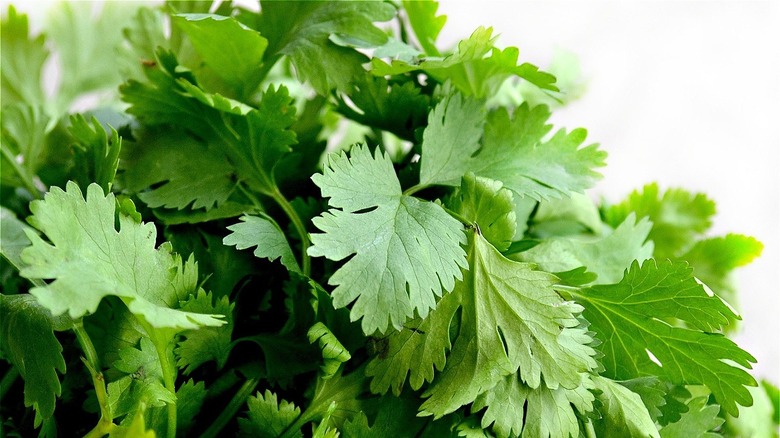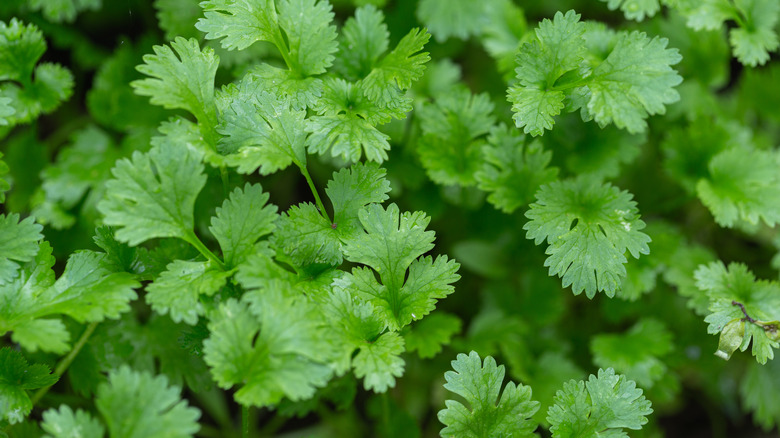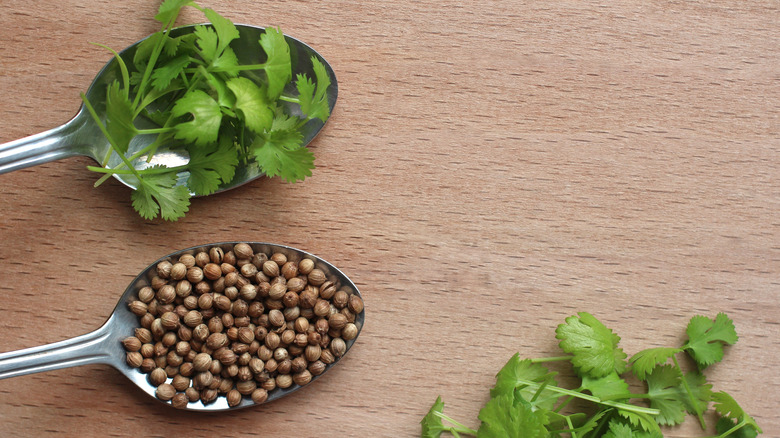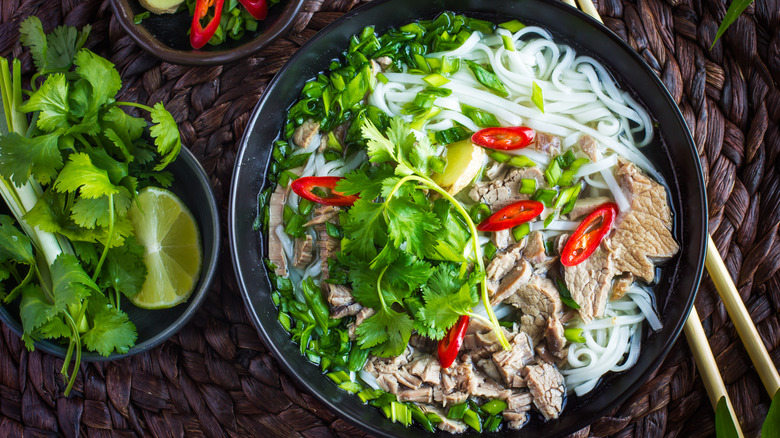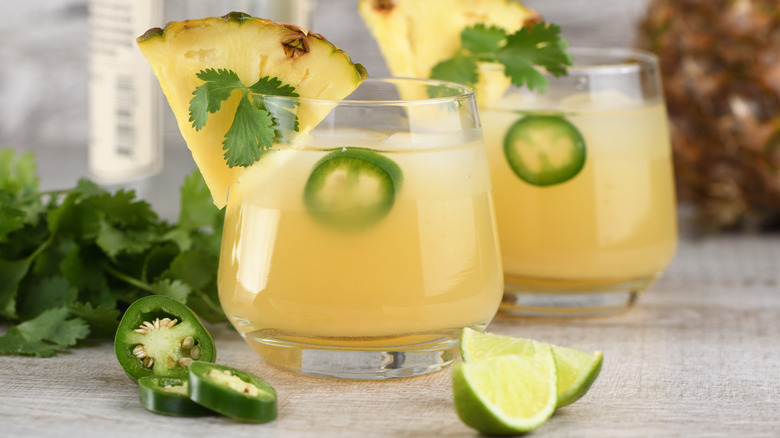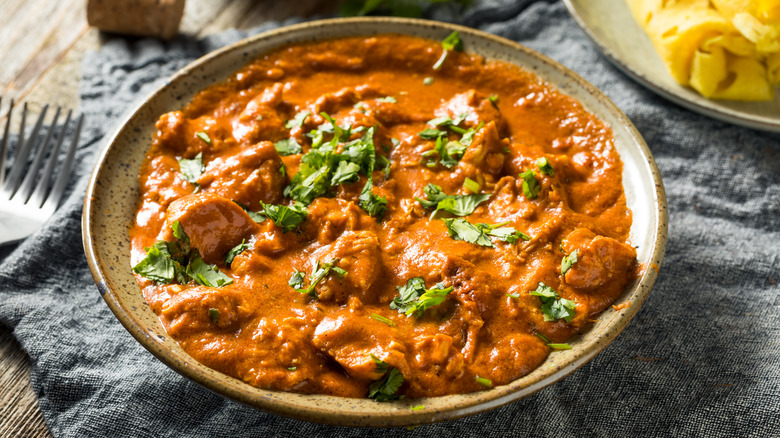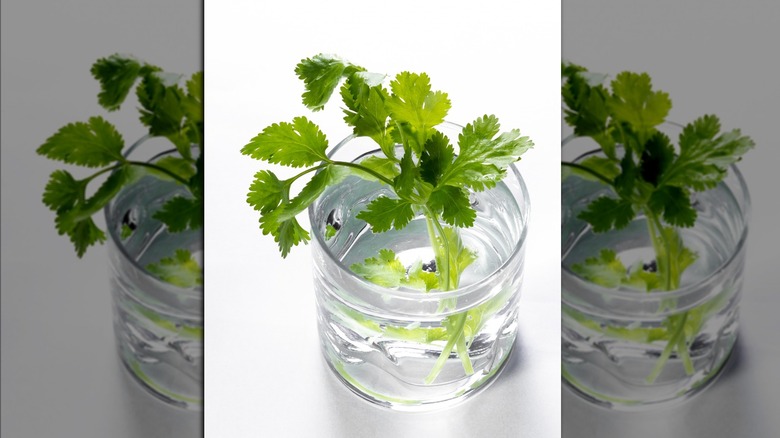What Is Cilantro And What Does It Taste Like?
Cilantro is one of the most versatile herbs in the kitchen — and one of the most divisive. It's a staple ingredient in many Mexican, Indian, South and Southeast Asian, and Middle Eastern dishes. Most often eaten fresh, cilantro is a welcome addition in salsa, curry, and zesty dressings. Well, it's welcome to its legions of fans, at least. The world's many cilantro haters, however, find that just a hint of this oh-so-polarizing herb is enough to turn them off a dish entirely.
According to The Texanist, cilantro wasn't all that well known in the U.S. until the 1970s. As it grew in popularity, it seemed to take on a near-ubiquity that dismayed those who couldn't stand the herb. Among its most prominent haters was Julia Child, who once told Larry King, "I don't like cilantro. ... [it has] kind of a dead taste to me" (via CNN). When he asked if she would ever order a dish containing this ingredient, she replied with an emphatic "Never. I would pick it out if I saw it and throw it on the floor." Diana Kennedy, a chef that José Andrés once called the "Indiana Jones of food," held the opposite point of view, Saveur reports. When asked how to accommodate the cilantro-averse in the film "Diana Kennedy: Nothing Fancy," she replied, "If people say they don't like cilantro, please don't invite them."
What is cilantro?
It can be easy to confuse cilantro with parsley at the grocery store if you're not careful. While cilantro is actually in the same herb family as parsley and has a similar leafy green appearance, it tastes quite different. You can recognize the herb by its more rounded leaves and bright, citrusy smell, Healthline suggests.
NPR reports that cilantro has been around for millennia and was first discovered in 8,000-year-old caves in Israel. So popular was this herb in ancient times that even King Tut had cilantro seeds scattered in his tomb. Although the herb is native to the Mediterranean and Middle East, it is now used globally. You might have heard cilantro called different names all over the world, like Chinese parsley, Mexican parsley, or fresh coriander. What's the difference here? Cilantro refers to the leaves and stems of the Coriandrum sativum plant, while the dried seeds of the plant are known as coriander, Healthline explains. Still, you can eat every bit of the cilantro plant, even the root, though topping your tacos with that part might introduce a totally different flavor.
Fresh cilantro vs. dried coriander
Fresh cilantro, as Healthline reveals, is more than 92% water. If you compare fresh cilantro to coriander seeds, you will see that a similar-sized serving of the two shows the latter to be much higher in both dietary fiber and minerals. These stats may be a bit misleading, though, as you are likely to be consuming a much smaller amount of cilantro than you would of coriander.
Cilantro and coriander, interestingly enough, have very little in common when it comes to flavor. Cilantro either tastes fresh and citrusy or nasty and soapy (depending on your genetic pre-disposal to like or loathe the stuff), while coriander is earthy, warm, and spicy and can be compared to cumin. It is often paired with this similar seed, as well as with cinnamon. While Coriandrum sativum's seeds may not be nearly as popular as its leaves, coriander is also not hated by large numbers of people, as it doesn't seem to have the same polarizing effect on flavor receptors.
When used in cooked dishes, cilantro is typically added right at the end since its flavor doesn't stand up well to prolonged heat. Coriander, on the other hand, can be simmered in soups and stews, rubbed on meat before roasting or grilling, or baked into bread. There is even a popular Indian snack, dhana dal, that consists of crushed, roasted coriander seeds.
What does cilantro taste like?
People who enjoy cilantro often find the herb to taste somewhat lemony, or perhaps they might describe it as bright and fresh with a hint of pepper. Others, however, claim that it tastes like a spoonful of dish soap and, needless to say, feel nothing but disdain for the herb. This soapy flavor isn't random: It comes from the herb's naturally occurring aldehyde compounds, which also happen to be produced when making soap, explains Delishably. People with European ancestry are the most genetically predisposed to detect the soap flavor, found a study shared in BioMed Central, which is why you won't find cilantro in many Western dishes. Interestingly, another study on the site found that only 17% of Caucasian test subjects disliked cilantro, compared with 21% of East Asians, and yet the herb is very prevalent in East Asian cooking. Go figure.
If you've yet to try cilantro, the only way you're ever going to know which side you're on is to take a nibble and see how it goes. Luckily, cilantro tends to be used as a garnish in most dishes, particularly with spicy foods since its green, fresh taste can temper the heat to some extent. If the garnish is in the form of a whole stalk, then that's all the better, as you can easily remove it should you find you don't care for its flavor.
How to cook with cilantro
The first thing to do before cooking with cilantro is to wash it thoroughly to remove any grit and dirt that may be on the stems and leaves, Spiceography instructs. From there, separating the leaves from the stems and garnishing your dish with the whole leaves will do the trick. Many cooks, however, prefer to chop the leaves to the size of their choice, while others like to use the stems as well. Because cilantro can lose its flavor when cooked, the herb is best used as a garnish at the end of cooking or mixed in with other fresh ingredients, as is done with salsa and pico de gallo. If you want to add it to a smooth sauce, it is best to pulse it in a food processor. In a chunky dip like guacamole, chopped cilantro is fine.
You'll commonly find cilantro atop tacos and in dishes like chicken tikka masala, chutney, chermoula, pad thai, and zhug, where its freshness makes everything pop. Cilantro can also be a great way to liven up many other dishes and beverages. If you are tired of the same old salads, margaritas, or fish tacos, you could always try spicing (well, technically herbing) them up with a sprig or two of cilantro.
Where to buy cilantro
Cilantro is a popular and well-known herb, so it can be found in just about any supermarket in the fresh produce section. Of course, just to make things confusing, it will likely be right next to its lookalike-but-not taste-alike cousin, parsley. Cilantro is typically sold by the bunch, so you will get plenty of long green stems as well as leafy tops. (Should you come across a recipe that tells you to snip off the latter and discard the former, Chef Aarón Sánchez advises you to ignore that directive as the stem is where the real flavor lies.)
The Spruce Eats says that when you are cilantro shopping, you should look for a bunch that's bright green in color. Once you've found one, pick it up and hold it upright from the bottom. If the cilantro is fresh, the stems should stay upright rather than droop.
Nutritional information about cilantro
Cilantro's high water content makes it low in calories, which is pretty typical for an herb. Healthline says that a cup of the stuff (which is a lot, even for a true cilantro lover) has only about 4 calories. Predictably, this serving size also contains only trace amounts (less than a single gram) of carbohydrates and fat, although the downside is that cilantro is practically protein-free, as well.
On the upside, cilantro does have a bunch of vitamins, including A, C, and K. It also has small amounts of some minerals, including potassium and manganese, but not enough to get you anywhere near your daily goals. Though it may not be a nutritional powerhouse when consumed in average amounts, cilantro could well offer certain health benefits. Although more studies would need to be conducted in order to determine the extent of these, some preliminary research does seem to indicate that cilantro may help to reduce inflammation, lower blood sugar levels, and fight off infections.
The best way to store cilantro
If you want the freshest possible cilantro, you could always try growing your own. Bonnie Plants says the best time to start your cilantro plants is in the fall or early spring, as they do well in cooler weather. These plants should be kept moist in well-draining soil.
If you've just picked up a bundle of cilantro at the supermarket, you'll need to make sure you've stored it properly as leafy herbs can spoil rather quickly. The best way to keep cilantro fresh to refrain from washing it until right before you use it, according to The Spruce Eats. Treat cilantro a bit like fresh flowers, and keep the stems in a cup of water with a loosened plastic bag covering the leaves. Cilantro can be kept in the fridge, but it won't be good beyond a week. Another trick to keep cilantro fresh for even longer is to first blanch the herb, then dry it and store it in a freezer-safe bag. Other options include freezing cilantro in ice cube trays along with a neutral oil or mixing the herb with salt and then storing it in the fridge. These hacks work particularly well when you'll be using the cilantro in a blended recipe such as salsa, guacamole, or pesto.
